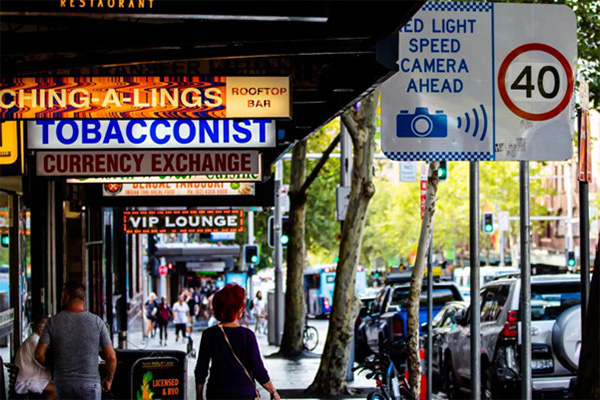Doctors for the Environment Australia demand a plan for Oxford Street that puts people first.
Doctors for the Environment Australia (DEA) understand the vital link between a healthy environment and overall wellbeing. In order to emphasize their point and garner support, DEA have written a compelling letter to decision makers.
DEA NSW, comprising doctors from diverse specialties, strongly supports the Oxford Street East cycleway, recognizing its significant health benefits. Moreover, they highlight the prevention of collisions between cyclists and motor vehicles, especially for children who are at high risk. To ensure safety, separate spaces for pedestrians, bike riders, and vehicles are essential.
Sad. From fashionable high street to unhealthy traffic sewer. Read more about Oxford Street’s long and fascinating history as Sydney’s most iconic shopping and entertainment strip here. (Image: Sydney Morning Herald)
Only the fit and brave ride down Oxford Street and that needs to change
Consequently, DEA NSW strongly advocates for the Oxford Street East cycleway, recognizing its significant health benefits. The group has written a compelling letter of support to decision makers to encourage them to build a better Oxford Street.
“Let’s bring back the Golden Mile!” Transport Minister Haylen and Bicycle NSW reimagining a healthier, people-friendly Oxford St (Credit: Jack Begbie)
Although Oxford Street is one of Australia’s busiest cycling corridors, it’s mainly fit men who ride because the streets are unsafe. Cycleways separated from traffic however, enable people of any ability to ride. That’s because 70% of the general are public interested in bike riding but scared of getting mown down. Dedicated cycleways also prevent conflict with pedestrians.
The problem with active transport along Oxford Street is that there’s not enough of it
With six roaring lanes of motor traffic and clearways shunting buses inches from footpaths, there’s little wonder shops are languishing. Without reducing road space for cars and increasing tree-lined footpaths and cycle ways, there’s no place to be.
Because who wants to dine outdoors when you can smell the diesel and can’t hear your friend.
Nowhere to sit (Credit: Sydney Morning Herald)
In addition to promoting safety, cycleways reduce reliance on motor vehicles.
This is crucial for our health and the environment. Currently, there are over 2 million car trips under 2 km made daily in Sydney, resulting in severe health and environmental consequences. So DEA NSW highlights two effects of this car dependency:
1. Vehicular emissions and particulate matter contribute enormously to respiratory disease, hospital admissions, disability and death.
A recent study into the effects of NO2 from tail pipe exhaust and dust particles provoked a stark readjustment of the Australian road toll:
- Australian road deaths for 2022 = 1187 people.
- Current estimated premature death toll due to vehicular emissions = 11 105 people.
- Total road deaths for 2022 = 12,292 people.
The same road pollution also contributes to 12,210 cardiovascular hospitalisations, 6,840 respiratory hospitalisations, and 66,000 childhood asthma cases every year. And Australian children are more likely to be killed on the road than any other premature cause of death. EA NSW therefore recognises that encouraging active travel and reducing car use lowers hospital admissions.
2. Obesity: Australia is facing a preventable disease and obesity pandemic that dwarfs COVID
‘Due to intergenerational inactivity, Australia faces an obesity pandemic with 25% of Children and 67% adults already regarded as overweight or obese’. Dr Shaun Watson, Neurologist.
In the 1980s, 75% of kids walked or rode to school. But after four decades of car-centric urban planning, that proportion plummeted to 25%. This has had disgraceful public health consequences. For example, Australian Teens now rank 140 out of 146 of the least physically active nations on the planet! (The Lancet)
Putting people first and cars last. Credit: Nicole Baker (2021)
In terms of cost, a 2022 report estimated an annual health bill of $1.75 billion in NSW due to motor vehicle-related issues. Which is why we need to reallocate road space for active travel.
‘Embracing initiatives like the Oxford Street East cycleway can bring Australia closer to achieving Vision Zero objectives.’ Dr Nicholas Williams, Neonatologist
Implementing the Oxford Street East cycleway aligns with City of Sydney's sustainability goals. By transforming the CBD into a pedestrian and cyclist-friendly area, the city can promote a greener and healthier environment.
Sign the petition to build a better Oxford Street HERE
Hey! It’s EOFY time. Want to put your tax-refundable dollar to great work?
‘If you care about the environment, health, cost of living, social equity and childhood independence, consider supporting our bike advocacy,’ Says Bicycle NSW CEO, Peter McLean. ‘Bicycle NSW has been campaigning for safe, accessible bicycle infrastructure for almost 50 years’






